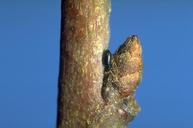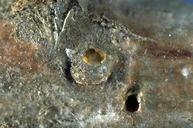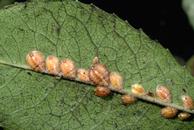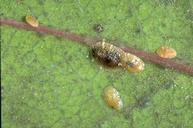Names link to more information on identification and management.
Click on photos to enlarge

Mealy plum aphid egg
Identification tip: Eggs are black, oval, and laid on or adjacent
to buds. Waxy filaments (not visible here) may be seen with a hand
lens. |
No photo available
Leaf curl plum aphid
Identification tip: Closely resembles the mealy
plum aphid egg but is smoother and has no waxy filaments. |

San Jose scale nymphs (healthy)
Identification tip: The four round, dark scales in the center
are the black cap stage, the most common overwintering form. The
earlier white cap stage is to left. |

San Jose scale (parasitized)
Identification tip: Scales parasitized the previous season
will have a round hole in them where the adult parasite emerged. |

European fruit lecanium nymphs
Identification tip: Look for legless, immobile yellow insects
on twigs. Older nymphs may have brown markings and a distinct center
ridge. |

European fruit lecanium
scale (parasitized)
Identification tip: Parasitized lecanium scales,
such as the one in the center here, turn black. |

European red mite eggs
Identification tip: Masses of eggs may be laid together. Each
slightly flattened red egg has a long, spinelike projection, called
a stipe, at the top that can be seen with a hand lens. |

Brown mite eggs
Identification tip: Brown mite eggs (shown here with adults)
look like those of European red mite, but lack the stipe. |


